Skills, experience, intent, patterns: AI sees what humans miss. Job boards that harness this intelligence are rewriting the rules of recruitment. What used to be hundreds of scattered PDFs is now structured data, predictive insights, and candidate-job alignment at scale.
If your hiring flow still depends on manual resume reviews, you’re not just moving slow, you’re losing your edge. In this guide, you’ll learn how to implement AI-powered resume screening that transforms your job board into a smart, scalable hiring engine built for the future.
The perfect candidate is no longer lost in a pile of resumes
Why job boards are using AI to sort through resumes faster
The old model of resume screening is breaking under the pressure of new hiring needs. As job boards expand and are exposed to more applications, the sheer volume of candidate resumes is clogging the platforms with crippling bottlenecks.
As hundreds of irrelevant resumes find their way onto their desk every minute, recruiters simply do not have the time to sort them out manually. Actionable results, data-driven shortlisting, and even smart automation are what companies need today. This visibly mirrors the function of AI in job boards: optimizing candidate review, eliminating inefficiencies, and making hiring scalable.
From here on in, intelligent screening software is a must-have, redefining the way sites manage talent acquisition at scale.
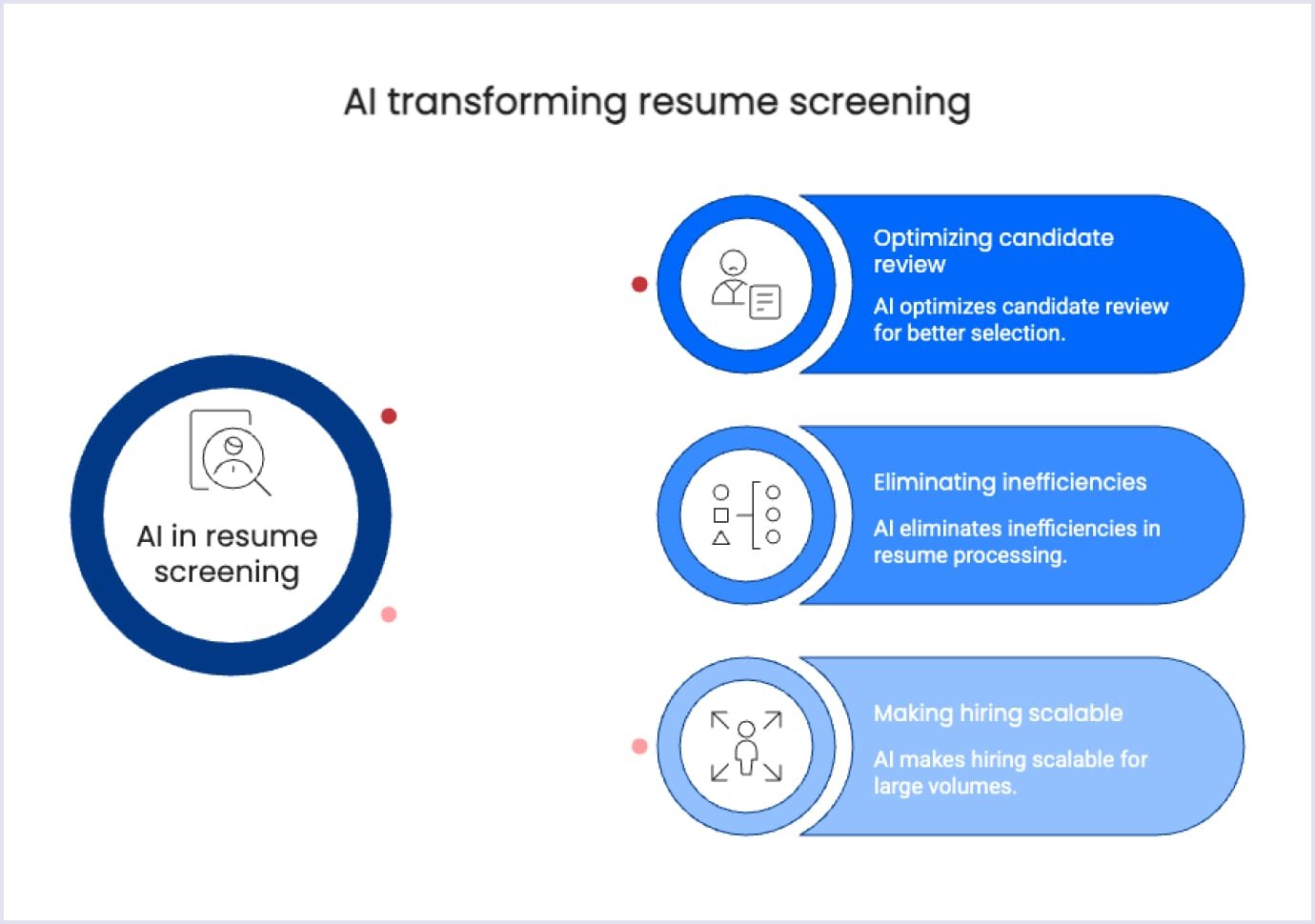
If Netflix can predict what you’ll watch, your job board can predict who gets hired
Job boards were once searchable databases. Candidates would post resumes, and companies would post openings, hoping that resume keyword extraction would facilitate the match. Keyword reasoning, though, is blunt, missing context, finesse, or generalizable skill. The result? High-quality candidates lost in irrelevant listings or altogether overlooked.
Both niche job boards and general job boards are confronted with this, although each in its own specific challenge: niche sites require very fine-grained, context-dependent matching, and general ones must deal with volume and varied quality. AI changes that calculation. Instead of seeing resumes as documents to screen, it sees them as structured datasets. With resume parsing technology powered by natural language processing for HR, websites are able to parse and normalize resume data: skills, job title, education, and match it more intelligently with job postings using semantic matching technology.
Semantic understanding and predictive ranking
Screens of today's AI do not merely match keywords, it reads in between. With machine learning in hiring, such systems continually upgrade their understanding of what the job requires and the ideal candidate profile. AI-driven candidate matching algorithms and hiring predictives allow the platforms to give accurate shortlists, rank the candidates, and match them with the available roles: all in real-time.
This enables job boards to offer automated job matching, candidate ranking systems, and explainable insights, increasing transparency and improving resume screening accuracy.
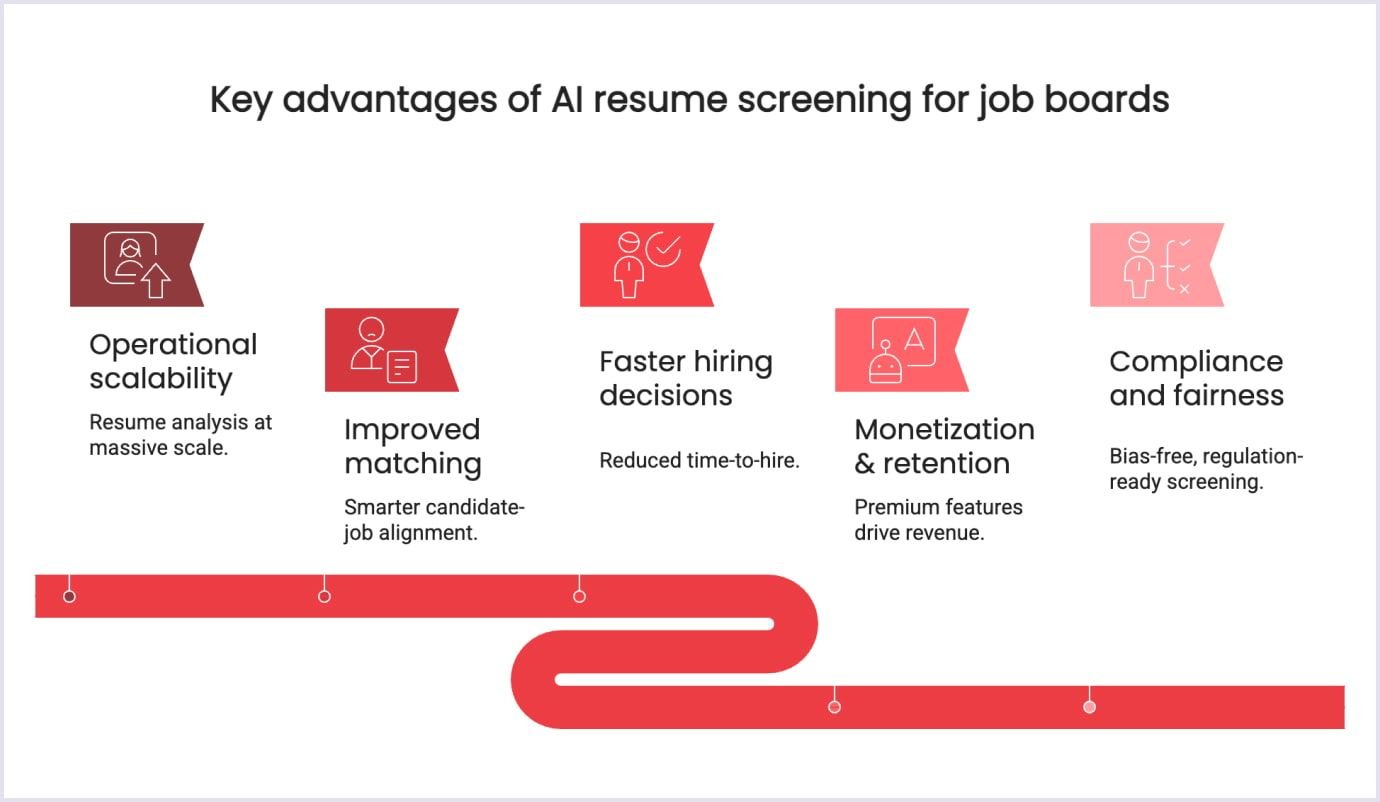
For job boards, embracing AI resume screening tools offers significant advantages:
- Operational scalability. AI automatically performs resume data analysis on thousands of candidates.
- Improved matching. Enhanced job description alignment and candidate qualification assessment lead to improved hires.
- Faster hiring decisions. Better hiring efficiency metrics decrease time-to-hire.
- Monetization & retention. Hiring managers possess AI recruitment ROI transparency and will be more likely to pay for next-gen features like applicant tracking system integration or access to your resume screening API.
- Compliance and fairness. Modern platforms are complemented by AI recruitment compliance and the use of objective hiring algorithms, reducing legal exposure while promoting ethical and inclusive hiring processes.
In the end, AI converts job boards into talent acquisition platforms that power true business outcomes. AI-based screening is the foundation of any job board struggling to survive in today's digital hiring landscape. It brings together HR tech stack innovation, recruitment process automation, and candidate sourcing automation into one comprehensive solution.
Hiring platforms looking for the highest level of integration and growth opportunities are supported by expert AI development services.

How AI knows which candidates fit the job best
Hiring is no longer about who applies: It’s about who fits
The biggest challenge isn't collecting resumes, it's interpreting them in context. What makes an individual the best fit is often buried in nuanced career histories, transferable skills, and trends that aren't revealed by keyword matches. AI solves this problem not by reading more resumes, but by reading them more deeply.
Key technologies powering AI resume screening
At the heart of this revolution is a shift from inflexible, rule-based filters to adaptive learning systems. AI screening doesn't rely solely on hard-coded logic. It is constantly learning. From results, feedback loops, and hiring decisions, to better understand what "fit" actually means for different roles, industries, and teams.
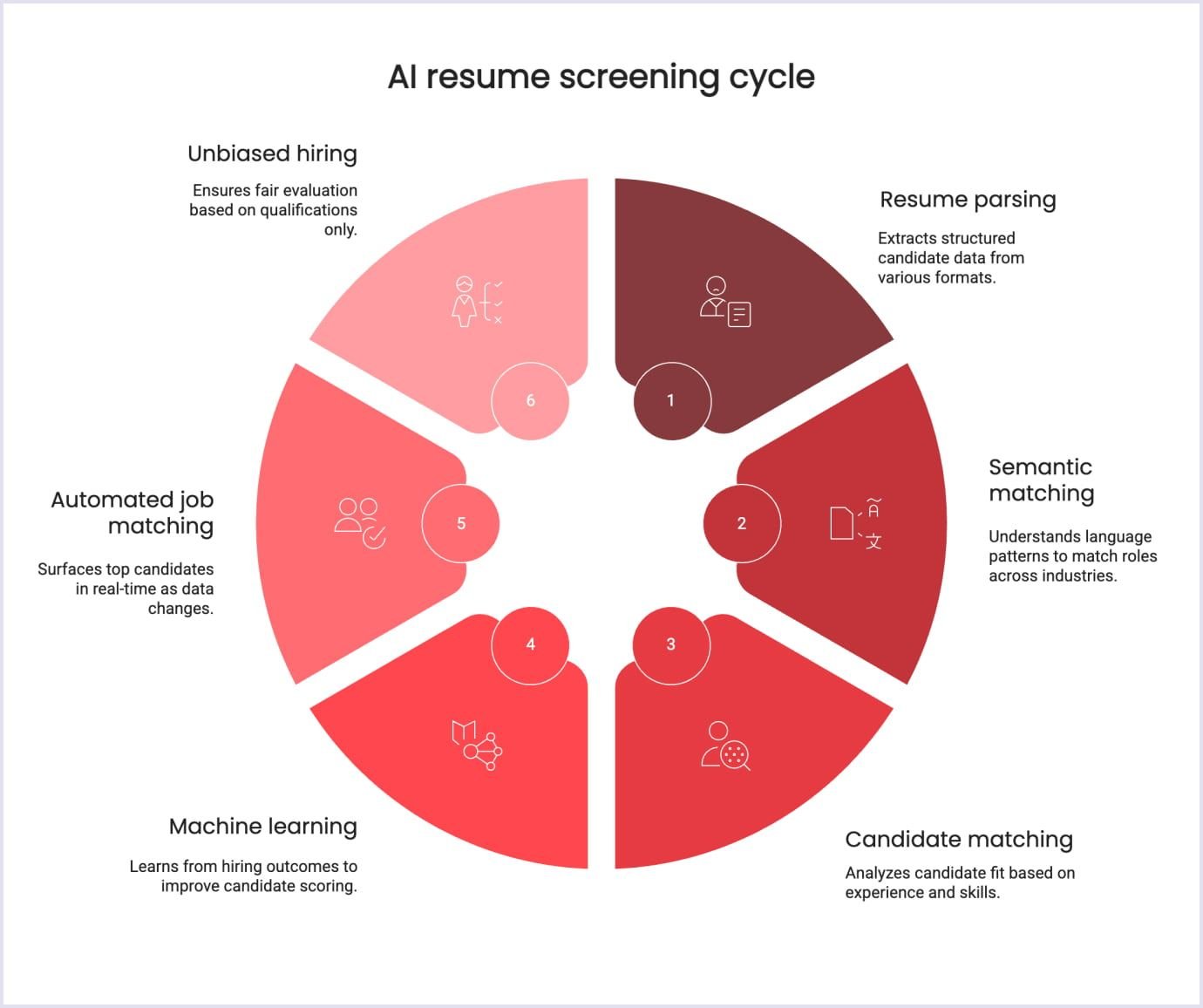
Instead of asking, "Are there the right words on this resume?", AI asks, "Does this candidate demonstrate the competencies, experiences, and growth markers that indicate success in this role?". It's a contextual assessment powered by multiple, interconnected technologies:
- Resume parsing technology. Enables structured extraction of critical candidate data: titles, education, achievements, and timelines. Normalizes different formats and enables systems to begin comparing at scale.
- Semantic matching technology. Goes beyond keyword comparison by understanding patterns of language. For example, it knows that "team lead" in a startup is the equivalent of "project manager" in a corporation, bridging the gap between role, responsibility, and function.
- Candidate matching algorithms. These utilize predictive hiring analytics to analyze how closely a candidate's background fits the job description, including depth of experience, industry relevance, and even soft skills based on writing style or career path.
- Machine learning for recruitment. Learn continually from successful hires and mismatched failures. It identifies traits of high performers and scores candidates accordingly, improving accuracy over time.
- Automated job matching. After patterns are established, the system can automatically surface top candidates for every posting in real-time, dynamically adjusting as new candidates enter the pipeline or job requirements shift.
- Unbiased hiring algorithms. Built-in fairness layers ensure decisions are not biased on the basis of race, gender, age, or other protected classes. Instead, these systems only consider qualification signals, making AI recruitment compliance and ethical hiring possible.
What constitutes a "fit" is usually not fixed. A candidate who isn't right for one job may be perfect for another next week. AI gets around this flexibility by maintaining candidate profiles as dynamic data objects: receptive to new data, comments, and changing job requirements.
In addition, AI can also assess latent fit, identifying top potential candidates whose value is not obvious from surface attributes. This is especially important for specialized roles, where traditional resumes don't always reveal real-world experience or transferable skills.
By looking at historical hiring trends, outcome-based success factors, and those used in comparable industries, AI builds a fluid template of what a "successful hire" should look like in the present moment and adjusts its screening models accordingly.

Implementation guide: Integrating AI resume screening into your job board
So you're eager to add AI to your job board, great. But where do you even start? Let's outline the four simple steps so you can add resume screening AI to your existing hiring process in a way that doesn't disrupt it.
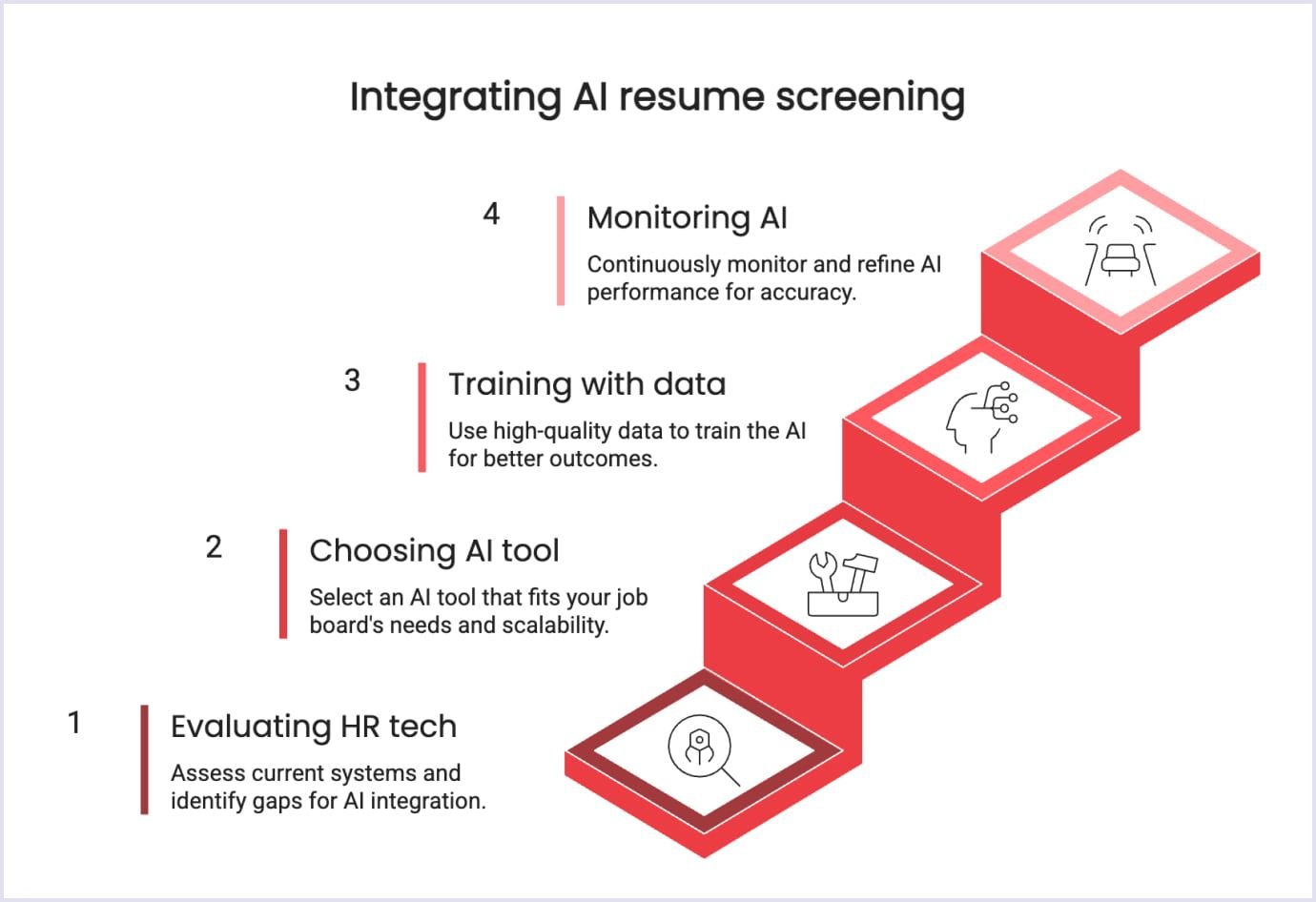
Step 1: Evaluating your current HR technology stack
Before you introduce AI, you need to know what your platform can already do and where it's deficient. This step is all about identifying the disparities between where your job board now is and where smart automation can lead it. You're looking at both the HR technological stack as well as the hiring workflows the latter facilitates. Key areas to evaluate in your stack:
- Resume database composition: Is data retained, searchable, scalable?
- ATS functionality: Are you utilizing tools like Greenhouse or Workable?
- Parsing tools: Are resumes parsed using Sovren, Rchilli, etc.?
- API & integration: Can systems talk using RESTful endpoints?
- Search & filtering logic: Still keyword-based or moving towards semantics?
A well-functioning AI system needs a solid data layer. If your website is saving resumes as PDFs or has outdated filters, there is little for the AI to operate with. This evaluation clears the path for seamless integration and peak performance.
Step 2: Choosing the right AI-powered screening tool
Not all AI tools are built equal. Neither are all built for job boards. Some are built to engage enterprise recruiters, and others to engage volume matching or candidate rediscovery. Your goal is to find a system that integrates on your site and for your users, employers and job seekers alike. Top AI resume screening sites to look into:
- HireVue: AI testing alongside video interview assessment.
- Textkernel: Premium parsing and semantic search engine.
- Pymetrics: Soft skill and behavioral trait analysis.
- Fetcher: Candidate sourcing automation meets profile intelligence.
- SeekOut: Deep talent analytics, diversity optimization features.
Look for tools that use natural language processing, provide real-time scoring, and allow for clear reasoning. The best options will not only suggest matches, but also explain why a candidate is a good fit. This will help recruiters make decisions faster and more confidently. Make sure your selection can adapt as the number of visitors and jobs increases.
Step 3: Training AI with high-quality data
AI is only as smart as what it is trained upon. If your platform gives it bad resumes, unclear job ads, or biased hiring histories, it will spit out bad results. The secret to good AI matching is clean, rich, and well-structured data. Not more data, but better data. Important training data sources and methods:
- Labeled resume outcomes: Which hires were successful, and which weren't?
- Normalized job posting libraries: By role, seniority, industry.
- Recruiter interaction data: Whom they shortlist, reject, revisit.
- Candidate engagement metrics: Time on job pages, click-throughs.
- ATS decision trails: Final hires and rejection reasoning.
You’re building feedback loops into the system, when recruiters reject a top suggestion, that informs the algorithm. When a hire leads to success, that signals the model what “fit” looks like. Over time, your AI becomes more personalized to your platform's hiring context.
Step 4: Monitoring and refining AI performance
AI is not a static state, it's a moving target, and it needs your input to keep it on track. Oversight maintains the system's accuracy, lack of bias, and alignment with recruiter expectations. If left uncontrolled, algorithms drift, exacerbate bias, or yield irrelevant candidates. Leading tools and methods for monitoring performance:
- Weights & Biases: To track model drift over time.
- WhyLabs: To detect bias and anomalies in predictions.
- Tableau or Looker: To visualize AI outputs and recruiter feedback.
- Manual review interface: To allow recruiters to override and comment.
- A/B testing setups: To validate new versions of the AI before they are widely released.
You'll want to track KPIs like match quality, diversity balance, and conversion to hire. Apply these learnings to retrain models from time to time and adjust matching thresholds. Think of your AI like a recruiter-in-training, it gets smarter every time you coach it.

Optimizing the user experience for employers & candidates in job board marketplace
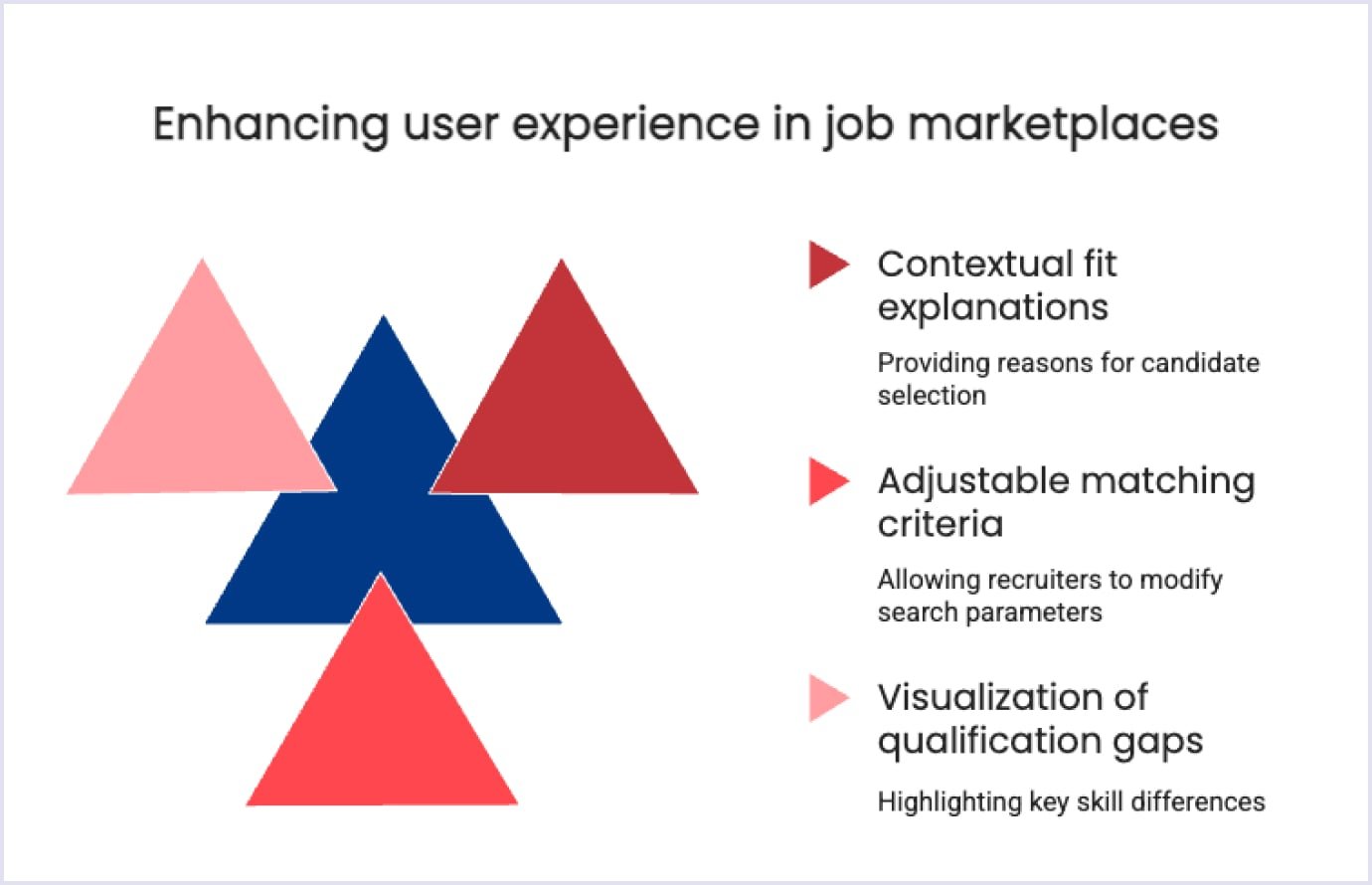
AI must not only be robust, it must also be visible and interpretable to the users who interact with it. Employers will never trust automated screening if they cannot interpret and adjust its logic. Good UX makes AI behave like a recruiter's assistant: transparent, responsive, and grounded in real hiring needs. To achieve that, your interface should:
- Show "why this candidate" with contextual fit explanations;
- Enable recruiters to adjust matching criteria without leaving the flow:
- Visualize key qualification gaps in side-by-side comparison mode.
For applicants, transparency is empowerment. When they understand not just rejection, but why and what next, AI is a coach, not a gatekeeper. This builds loyalty and engagement while subtly educating users to harmonize with the platform's logic, making better matches over time, for all parties.
To make your platform both as intelligent as it is user-friendly, professional UI/UX design services are essential right from the very beginning.
Monetizing AI resume screening in your job marketplace
AI recasts what your site really sells: not job listings, but recruitment success. As AI begins to produce measurable outcomes (highly relevant shortlists, increased offer acceptance, reduced churn), it's not about pricing for presence anymore, but predictive power. Your business model has to adapt to this shift from fixed listings to dynamic, evidence-based decisions:
- Sell live match scores and ranking algorithms;
- Apply pay-per-use arrangements for AI-facilitated resume parsing;
- Offer branded AI toolkits for embedding inside internal HR systems.
These capabilities are revenue drivers that monetize your backend intelligence into repeatable, scalable revenue. With premium pricing, usage APIs, or custom enterprise solutions, profiting from AI is about creating an insight infrastructure that your customers can rely on every day.

If your job board doesn’t use AI, it’s already behind
Behind every resume, there is a person, and behind every smart platform, there must be technology that sees beyond keywords. AI enables job boards to find not just candidates, but connections. Proper execution speeds up hiring, makes it fairer, and more human.
At Codica, success isn't an add-on, it's built in. We create customized solutions that deliver noticeable business results. Check out our portfolio to see how we bring strategy to life with scalable digital products. Have a project idea? Let’s discuss it today, contact us.
